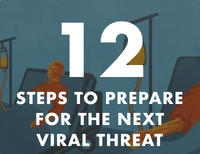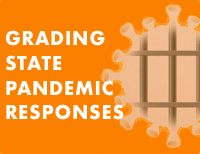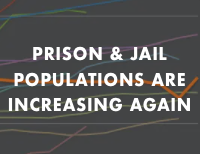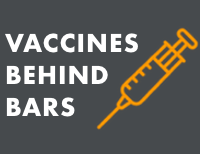COVID-19: archived resources
The following resources that we and our partners have produced about COVID-19 and the criminal justice system used to be on our main COVID-19 page. We have archived them on this page in case readers need to find them in the future.
Our work:
- COVID looks like it may stay. That means prison medical copays must go. — Forty states and the federal prison system continue to charge incarcerated people unaffordable copays for medical care.
 States of Emergency: The Failure of Prison System Responses to COVID-19 — We evaluated departments of corrections on their responses to the COVID-19 pandemic. Includes an appendix providing details about each state.
States of Emergency: The Failure of Prison System Responses to COVID-19 — We evaluated departments of corrections on their responses to the COVID-19 pandemic. Includes an appendix providing details about each state.
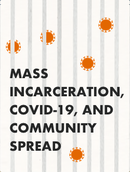 Mass Incarceration, COVID-19, and Community Spread — We published the first report measuring the impact of mass incarceration on COVID-19 caseloads inside and outside prisons, including national-, state-, and county-level data.
Mass Incarceration, COVID-19, and Community Spread — We published the first report measuring the impact of mass incarceration on COVID-19 caseloads inside and outside prisons, including national-, state-, and county-level data.
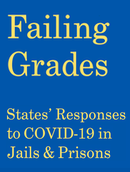 Failing Grades: States' Responses to COVID-19 in Jails and Prisons — We worked with the ACLU to evaluate the actions every state had taken by the summer of 2020 to protect incarcerated people from COVID-19. Includes an appendix providing details about each state.
Failing Grades: States' Responses to COVID-19 in Jails and Prisons — We worked with the ACLU to evaluate the actions every state had taken by the summer of 2020 to protect incarcerated people from COVID-19. Includes an appendix providing details about each state.
- Incarcerated people and corrections staff should be prioritized in COVID-19 vaccination plans — Our short 50-state report breaks down whether states are planning to vaccinate incarcerated people and corrections staff early.
- What do we know about the spread — and toll — of the coronavirus in state prisons? — Wide variation in the rates of reported infections and deaths in state prisons reflect the uneven spread of the virus and disparate responses by state criminal justice systems.
- State prisons and local jails appear indifferent to COVID outbreaks, refuse to depopulate dangerous facilities — Our February 2022 analysis (updating earlier analyses from October 2021, June 2021, February 2021, December 2020, September 2020, August 2020, and May 2020) finds that even as new Covid variants arise, the initial pandemic-era declines in prison and jail populations have slowed, and that state prison population declines are primarily the result of reduced admissions, not increased releases.
- COVID looks like it may stay. That means prison medical copays must go. — Forty states and the federal prison system continue to charge incarcerated people unaffordable copays for medical care.
- New data: The changes in prisons, jails, probation, and parole in the first year of the pandemic — Newly released data from 2020 show the impact of early-pandemic correctional policy choices and what kind of change is possible under pressure. But the data also show how inadequate, uneven, and unsustained policy changes have been: most have already been reversed.
- Since you asked: What information is available about COVID-19 and vaccinations in prison now? — Despite new variants, prison systems are not publishing necessary data and we don't know much about booster shot access.
- Criminal justice responses to the COVID-19 pandemic — Our regularly-updated list of the most significant recent policy changes in state and local governments.
- Just over half of incarcerated people are vaccinated despite being locked in COVID-19 epicenters — Most states did not prioritize incarcerated people in their vaccination plans. As a result, many in prison are still vulnerable to infection.
- A publication from the UCLA COVID-19 Behind Bars team reveals that COVID-19 reduced the life expectancy of people in Florida prisons by 4 years.
- With the majority of corrections officers declining the COVID-19 vaccine, incarcerated people are still at serious risk — Analysis of data from 37 prison systems shows that less than half of prison staff are vaccinated in most states.
- Parole boards approved fewer releases in 2020 than in 2019, despite the raging pandemic — Instead of releasing more people to the safety of their homes, parole boards in many states held fewer hearings and granted fewer approvals during the ongoing, deadly pandemic.
- More states need to use their “good time” systems to get people out of prison during COVID-19 — Most states have statutes that allow incarcerated people to earn time off of their sentences. Why aren't more states using this tool to safely reduce prison populations during COVID-19?
- Prisons shouldn’t be charging medical co-pays – especially during a pandemic — Our December survey of medical co-pay policies shows that some states are reinstating medical co-pays as COVID-19 continues to spread in prisons.
- How overcrowded were prisons before the pandemic, and at this time of social distancing, how overcrowded are they now? — As states mandate reducing the capacity of public spaces to slow the spread of COVID-19, we collect the data to show just how overcrowded almost every state prison system still is.
- Incarcerated people and corrections staff should be prioritized in COVID-19 vaccination plans — Our short 50-state report breaks down whether states are planning to vaccinate incarcerated people and corrections staff early.
- Half of states fail to require mask use by correctional staff — Our survey reveals that 20 states are not even requiring masks to be worn by staff and most are not requiring incarcerated people to wear them.
- Compassionate release was never designed to release large numbers of people — With help from artist Kevin Pyle, we explain why very few people who apply for compassionate release are approved, even during a pandemic.
- When parole doesn’t mean release: The senseless “program requirements” keeping people behind bars during a pandemic — We explain why thousands of people who have been approved for parole release are still behind bars.
- Stimulus, round 2: Incarcerated people will be eligible for new round of payments — At the end of an otherwise disappointing session of Congress, the inclusion of incarcerated people in the stimulus program is a small ray of hope.
- Since you asked: Should incarcerated people be receiving stimulus payments? Some correctional authorities - responding to bad guidance from the IRS - are intercepting stimulus checks for incarcerated people. We explain why people in prison and jail are eligible for, and should be receiving, emergency aid.
- Is social distancing possible behind bars? — The short answer is no. Social distancing is even harder behind bars than in nursing homes or on cruise ships.
- Large-scale prison releases and public safety We offer 14 recent historical examples to show that large-scale releases are possible without spikes in crime.
- Five ways the criminal justice system could slow the pandemic — We explain which criminal justice officials (and elected leaders) are responsible for preventing a human tragedy during the pandemic, and what policy steps they should take in order to do so.
- Our template letter for advocates to send to prisons and jails that have suspended in-person visits, requesting that phone and video calling fees be temporarily eliminated so that families can stay in touch.
- Yes, incarcerated people are eligible for the second round of stimulus checks (we also published an explainer on the first round of stimulus checks)
- Why you can be paroled but still in prison during COVID-19
- How compassionate release works (and often, doesn’t work)
- Is social distancing possible behind bars?
- Why even vulnerable people aren't "safer" or "better off" in jail
- How prepared were state prison systems for a viral pandemic? In April, we sent state prison systems a 5-question survey, and their answers — with one exception — were not encouraging.
- Our 50-state spreadsheet showing what each state Department of Corrections has told the public about its virus response plan.
- How to find and interpret crime data during the coronavirus pandemic: 5 tips — We offer guidance to reporters and members of the public investigating crime trends.
- Hundreds are still jailed for technical parole violations in NYC, which means decarceration is happening far too slowly — We explain what NYC's slow decarceration should teach other cities: Even releasing "low-level offenders" is a complicated process liable to be bogged down by delays.
- Our fact sheet: What’s in store if prisons and jails don’t decarcerate now — Our fact sheet shows how rapidly the coronavirus can spread through correctional facilities, and how high infection rates in prisons and jails already are.
Our visuals
We've created several powerful infographics illustrating prisons' failure to protect incarcerated people during the pandemic, including:
- Our 50-state map showing that few states made significant efforts to reduce prison populations between early 2020 and July 2021
- A three-year chart showing that the number of people released from state prisons each month has been falling since 2019, in at least 10 states with available release data
For more, see a full list of maps and visualizations describing the dire state of the pandemic in prisons and jails.
Medical research:
- Multiple medical journals have published articles calling for reducing prison and jail populations, as well as implementing other policies, to slow down the coronavirus. These include the Journal of the American Medical Association (JAMA), the New England Journal of Medicine, and Health Affairs.
- In a report published in April, the ACLU — in collaboration with researchers at Washington State University, University of Pennsylvania, and University of Tennessee — found that if jails continued to operate as usual, the number of U.S. fatalities due to COVID-19 could increase by another 100,000. They recommended swift intervention at multiple levels of government to reduce jail populations and prevent the number of fatalities in the U.S. from doubling.
- A July CDC study on COVID-19 testing in prison had two major findings. First, testing people who had had contact with the virus identified more people who were positive for COVID-19 than just testing people experiencing symptoms. Second, the researchers found that serial (repeated) testing of people helped identify people who were asymptomatic; this allowed for early detection, isolation, and treatment, which slow the transmission of the virus. States should not just test the incarcerated population and correction staff once; to save the most lives in and out of prison, states need to be regularly testing all incarcerated people and staff, regardless of the presence of symptoms.
- Health Affairs published an article in April recommending ways to protect and support people released from custody during the pandemic.
- In early September, the National Commission on COVID-19 and Criminal Justice released a report that found the rate of COVID-19 cases in prisons was more than four times that of the general population and the COVID-19 mortality rate in prisons was twice as large as that of the general U.S. population.
Data and information aggregators:
- The UCLA Law COVID-19 Behind Bars Data Project is tracking the spread and impact of the novel coronavirus in American carceral facilities, with state by state data on case numbers, fatalities, and more. Data from the project is available on both an interactive website and a comprehensive Google Sheet.
- The State Prison COVID-19 Risk Tracker, created by the Litmus Program at the NYU Marron Institute, is a census of state adult correctional and detention facilities with an interactive mapping tool of county-level data on COVID-19 confirmed cases and deaths, showing which facilities are located in or near counties that are at high risk for community transmissions of COVID-19.
- The Fines and Fees Justice Center is actively tracking federal, state, and local changes to criminal, traffic, and municipal ordinance fines and fees policies. On the same page, the FFJC also provides two concise but thorough lists of policy recommendations for communities and for the justice system.
- Professor Margo Schlanger at the University of Michigan Law School is tracking all COVID-19 class-action and group litigation (jails, prisons, immigration detention) cases at the Civil Rights Litigation Clearinghouse.
- The Sentencing Project created a tool to track known cases of COVID-19 diagnoses in juvenile facilities among incarcerated youth and the facility staff across the county.
- The Marshall Project is tracking articles from across the web on the risks of coronavirus across the U.S. justice system.
- The Justice Collaborative COVID-19 Response and Resource page offers resource lists, fact sheets, example demand letters, and tracks active demand campaigns throughout the U.S.
- The Urban Institute has a curated list of COVID-19 resources for leaders in international, federal, state, and local governments, as well as advocacy organizations.
- This crowdsourced spreadsheet lists authorities (medical, legal, governmental) speaking out about the risks to incarcerated people during the COVID-19 pandemic. This resource is being used by advocates who are writing petitions or pressuring decision-makers to take action.
- Professor Aaron Littman at the UCLA School of Law has compiled a spreadsheet to help readers understand which local officials have the power to release people from jails. The information in the spreadsheet is state-specific.
Selected demand letters and policy recommendations from other groups:
These are examples of some of the most powerful demand letters and policy recommendations made by experts around the country about mitigating the spread of COVID-19 in prisons and jails.
- Several organizations have recommended programs and policies to support people being released from prisons and jails during the pandemic:
- A coalition of formerly incarcerated people and current volunteers and employees of the Indiana correctional system proposed a model emergency release plan that addresses housing, quarantine, and healthcare issues.
- The Justice Collaborative Institute published a report in early May recommending ways to secure housing, medical care, smartphones, and other critical resources for returning citizens.
- The Council of State Governments Justice Center and the National Sheriffs' Association created a checklist for correctional facilities to prepare people for release and reentry. The checklist addresses COVID-19 testing, legal discharge processes, basic needs, and medical and substance abuse treatment.
- Amend at the University of California San Francisco released a short policy paper recommending ways to release people from prisons and "cohort" those still incarcerated to slow the spread of the virus.
- Advocates in Cook County, Illinois, Los Angeles, and Detroit published demands for the release of people from local jails.
- The NYC Board of Corrections (an independent oversight body) released a statement calling for the immediate release of people who are over 50 years old, have underlying health conditions, are detained for administrative reasons such as failure to appear, and people serving sentences of less than one year.
- The Bail Project released 6 sensible demands for jails to protect the public by: 1) releasing people who are held because they cannot afford a cash bond, 2) utilizing "cite and release" for people charged with misdemeanors, 3) prioritizing release for people in vulnerable demographics, 4) reducing conditions and restrictions around release, 5) protecting meaningful access to counsel and pretrial support, and 6) providing appropriate care and hygiene to those who remain incarcerated.
- Fair and Just Prosecution released a joint statement from numerous elected prosecutors recommending use of cite and release policies, releasing those people detained because they cannot afford bail, release vulnerable people, and eliminate medical copays.
- Youth Correctional Leaders for Justice released a statement -- endorsed by current and former youth corrections administrators -- making recommendations for youth correctional facilities to prevent the spread of COVID-19. Their recommendations include population reduction, elimination of fines and fees, and opportunities for detained youth to communicate with family.
- On March 23, the CDC released guidelines for correctional and detention facilties to protect the health and safety of incarcerated people, staff, visitors, and the community at large.
Polling data:
Data for Progress conducted a survey of 2,509 likely voters and found that across political parties, support for criminal justice reform to mitigate the risks of COVID-19 was strong. Respondents supported the reduction of jail and prison populations, releasing people within 6 months of completing their sentences, releasing at-risk individuals, and reducing unnecessary jail admissions.
Tools for legal action and advocacy:
The Civil Rights Corps released a template for emergency motions for pretrial release that advocates can file in any criminal case.
Events
- April 15-17, 2025:
Sarah Staudt, our Director of Policy and Advocacy, will be attending the MacArthur Safety and Justice Challenge Network Meeting from April 15-17 in Chicago. Drop her a line if you’d like to meet up!
Not near you?
Invite us to your city, college or organization.
 States of Emergency: The Failure of Prison System Responses to COVID-19
States of Emergency: The Failure of Prison System Responses to COVID-19 Mass Incarceration, COVID-19, and Community Spread
Mass Incarceration, COVID-19, and Community Spread Failing Grades: States' Responses to COVID-19 in Jails and Prisons
Failing Grades: States' Responses to COVID-19 in Jails and Prisons